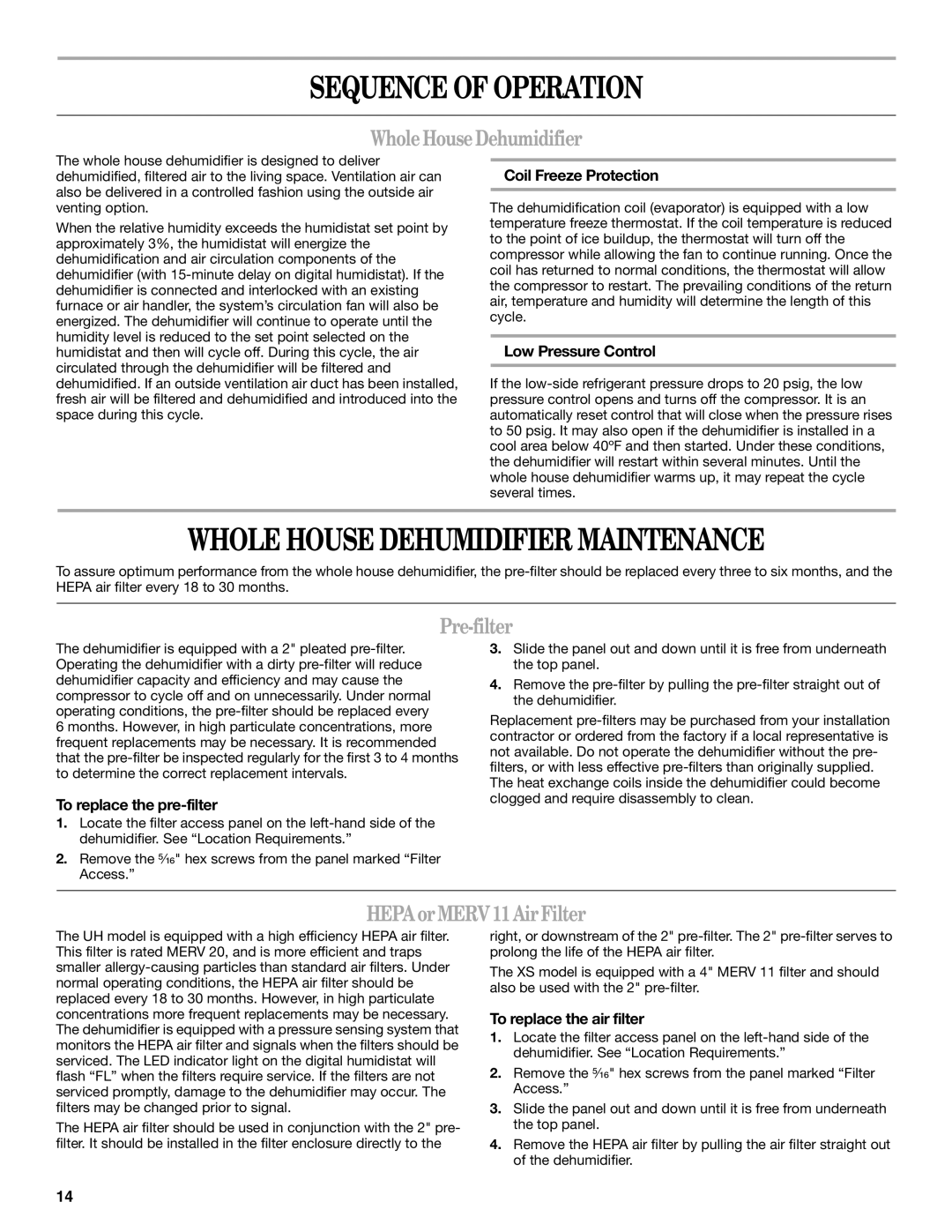SEQUENCE OF OPERATION
WholeHouseDehumidifier
The whole house dehumidifier is designed to deliver dehumidified, filtered air to the living space. Ventilation air can also be delivered in a controlled fashion using the outside air venting option.
When the relative humidity exceeds the humidistat set point by approximately 3%, the humidistat will energize the dehumidification and air circulation components of the dehumidifier (with 15-minute delay on digital humidistat). If the dehumidifier is connected and interlocked with an existing furnace or air handler, the system’s circulation fan will also be energized. The dehumidifier will continue to operate until the humidity level is reduced to the set point selected on the humidistat and then will cycle off. During this cycle, the air circulated through the dehumidifier will be filtered and dehumidified. If an outside ventilation air duct has been installed, fresh air will be filtered and dehumidified and introduced into the space during this cycle.
Coil Freeze Protection
The dehumidification coil (evaporator) is equipped with a low temperature freeze thermostat. If the coil temperature is reduced to the point of ice buildup, the thermostat will turn off the compressor while allowing the fan to continue running. Once the coil has returned to normal conditions, the thermostat will allow the compressor to restart. The prevailing conditions of the return air, temperature and humidity will determine the length of this cycle.
Low Pressure Control
If the low-side refrigerant pressure drops to 20 psig, the low pressure control opens and turns off the compressor. It is an automatically reset control that will close when the pressure rises to 50 psig. It may also open if the dehumidifier is installed in a cool area below 40ºF and then started. Under these conditions, the dehumidifier will restart within several minutes. Until the whole house dehumidifier warms up, it may repeat the cycle several times.
WHOLE HOUSE DEHUMIDIFIER MAINTENANCE
To assure optimum performance from the whole house dehumidifier, the pre-filter should be replaced every three to six months, and the HEPA air filter every 18 to 30 months.
Pre-filter
The dehumidifier is equipped with a 2" pleated pre-filter. Operating the dehumidifier with a dirty pre-filter will reduce dehumidifier capacity and efficiency and may cause the compressor to cycle off and on unnecessarily. Under normal operating conditions, the pre-filter should be replaced every
6 months. However, in high particulate concentrations, more frequent replacements may be necessary. It is recommended that the pre-filter be inspected regularly for the first 3 to 4 months to determine the correct replacement intervals.
To replace the pre-filter
1.Locate the filter access panel on the left-hand side of the dehumidifier. See “Location Requirements.”
2.Remove the ⁵⁄₁₆" hex screws from the panel marked “Filter Access.”
3.Slide the panel out and down until it is free from underneath the top panel.
4.Remove the pre-filter by pulling the pre-filter straight out of the dehumidifier.
Replacement pre-filters may be purchased from your installation contractor or ordered from the factory if a local representative is not available. Do not operate the dehumidifier without the pre- filters, or with less effective pre-filters than originally supplied. The heat exchange coils inside the dehumidifier could become clogged and require disassembly to clean.
HEPAorMERV11AirFilter
The UH model is equipped with a high efficiency HEPA air filter. This filter is rated MERV 20, and is more efficient and traps smaller allergy-causing particles than standard air filters. Under normal operating conditions, the HEPA air filter should be replaced every 18 to 30 months. However, in high particulate concentrations more frequent replacements may be necessary. The dehumidifier is equipped with a pressure sensing system that monitors the HEPA air filter and signals when the filters should be serviced. The LED indicator light on the digital humidistat will flash “FL” when the filters require service. If the filters are not serviced promptly, damage to the dehumidifier may occur. The filters may be changed prior to signal.
The HEPA air filter should be used in conjunction with the 2" pre- filter. It should be installed in the filter enclosure directly to the
right, or downstream of the 2" pre-filter. The 2" pre-filter serves to prolong the life of the HEPA air filter.
The XS model is equipped with a 4" MERV 11 filter and should also be used with the 2" pre-filter.
To replace the air filter
1.Locate the filter access panel on the left-hand side of the dehumidifier. See “Location Requirements.”
2.Remove the ⁵⁄₁₆" hex screws from the panel marked “Filter Access.”
3.Slide the panel out and down until it is free from underneath the top panel.
4.Remove the HEPA air filter by pulling the air filter straight out of the dehumidifier.

